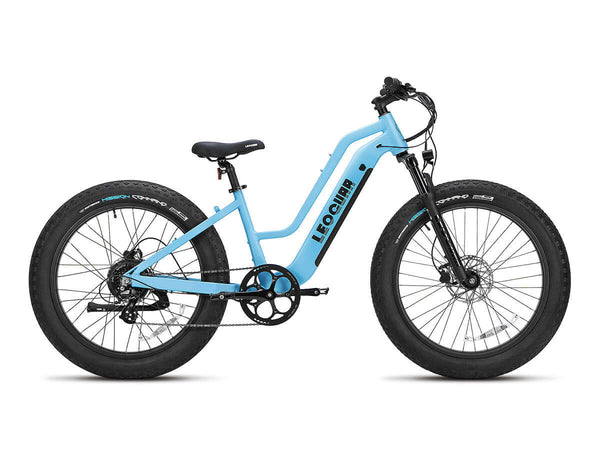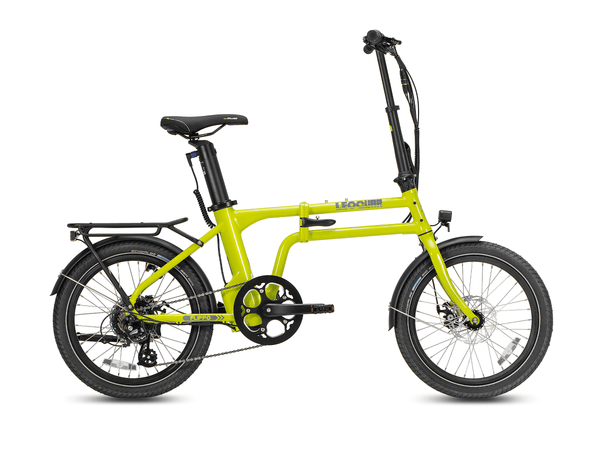
Is an Electric Bike with Removable Battery Worth It? Here’s What to Know
Why Removable is Better
When you're looking at electric bikes, one of the first big questions you'll face is about the battery. Should you get an electric bike with a removable battery, or is a sleek, built-in one better? For most riders, from daily commuters to weekend adventurers, the answer is a strong yes - an electric bike with a removable battery is absolutely worth it. The convenience, better security, and easier maintenance it offers are game-changers for daily use.
This guide will break down the pros and cons, compare removable batteries to their built-in counterparts, and show you exactly what to look for. We'll give you the expert insights needed to choose the perfect electric bike with a removable battery for your lifestyle.
A removable battery isn't just a minor feature. It changes how you charge, secure, and maintain your e-bike, solving practical problems before they even arise. Here's a detailed look at why we consider it a must-have for most riders.
Ultimate Charging Convenience
This is the number one reason to choose an electric bike with a removable battery. It frees you from the need to park your entire bike next to a power outlet.
- For apartment dwellers: Hauling a 50-70 lb e-bike up several flights of stairs or moving it into a cramped elevator is a daily struggle you can avoid. With a removable system, you simply lock your bike downstairs and carry the much lighter 7-10 lb battery inside to charge.
- For office commuters: You can't exactly wheel your bike into the meeting room. A removable battery lets you power up right at your desk during the workday. This ensures you have a full charge for the ride home, after-work errands, or a fun detour.
- For homeowners: Even with a garage, finding a convenient and safe spot to park and charge a full bike can be a hassle, leading to clutter. By bringing just the battery inside, you can charge it in a clean, temperature-controlled space while keeping your garage or hallway clear.
Enhanced Security and Peace of Mind
An electric bike is a big investment, and its battery is the most expensive and important part. Removing it is one of the most effective theft prevention methods available. An e-bike without its power source is far less appealing to thieves.
Imagine you're meeting friends at a café. You find a solid post to lock your bike frame to, but you're still worried about leaving a valuable piece of tech unattended. With a removable battery, you can unlock it in seconds, take it inside with you, and enjoy your coffee without worry. This provides a powerful second layer of security that a simple bike lock can't match.
Simplified Maintenance and Lifespan
Proper battery care is essential for long-term performance, and a removable battery makes this much easier. Lithium-ion batteries are sensitive to extreme temperatures.
Charging and storing the battery indoors protects it from the damaging effects of a hot garage in summer or a freezing shed in winter. According to experts, following the best practices for prolonging battery life includes avoiding temperature extremes, which a removable battery makes easier. Furthermore, when it's time to clean your bike, you can remove the battery and wash the frame without worrying about spraying water on sensitive electronics and connection points.
Greater Flexibility and Range
For long-distance riders, tourers, or delivery professionals, a removable battery system offers a unique advantage: the ability to carry a spare. If you're planning an all-day adventure or your job depends on your e-bike's range, you can easily pack a second, fully charged battery in a bag or backpack.
When the first one runs low, you can swap it out in under a minute and effectively double your range. This is a level of flexibility that is simply impossible with a fully built-in, non-removable battery.

Realistic Trade-Offs
To give you a complete picture, we need to acknowledge that removable battery systems do have a few potential downsides. While we believe the benefits far outweigh them for most people, it's important to be aware of the trade-offs.
Potential for Frame Rattle
The mechanism that locks the battery into the frame involves moving parts and tolerances. Over hundreds of miles on bumpy roads, this connection can sometimes develop a slight looseness, leading to a rattling sound. Good brands fight this with high-quality, strong locking mechanisms and tight-fitting housings, but it's a possibility to be aware of, especially on cheaper models.
Frame Design and Looks
This is largely a matter of personal taste. Built-in batteries allow for bike frames that are sleeker and look more like traditional, non-electric bicycles. An electric bike with a removable battery often requires a larger, bulkier downtube to house the battery pack and its locking system. While many modern designs are quite elegant, they typically have a more practical look compared to their fully built-in cousins.
A Minor Weight Penalty
The extra housing, locking mechanism, and reinforced frame structure needed for a removable system can add a small amount of weight - perhaps a pound or two - compared to a design where the battery is sealed directly into the frame. For the average rider, this difference is negligible and is easily offset by the convenience of being able to remove the 7-10 lb battery for transport or carrying the bike upstairs.
A Head-to-Head Comparison
To make the choice clearer, let's summarize the key differences in a simple table.
| Feature | Removable Battery | Built-in (Non-Removable) Battery |
|---|---|---|
| Charging Convenience | High. Charge the battery anywhere. | Low. The entire bike must be near an outlet. |
| Security | High. You can remove the most valuable part. | Moderate. Relies solely on the bike lock. |
| Frame Looks | Often bulkier, more practical look. | Sleeker, more traditional bike appearance. |
| Weight | Slightly heavier frame and housing design. | Potentially lighter overall frame design. |
| Range Extension | Easy. Swap in a spare battery on the go. | Impossible. Range is limited to one charge. |
| Maintenance/Replacement | Simple. Easy for the user to remove and replace. | Difficult. Usually requires professional service. |
Choosing a Quality System
Not all removable battery systems are created equal. Once you've decided that a removable battery is right for you, the next step is to learn how to spot a high-quality one. The difference between a good and a bad system lies in the details that go beyond the spec sheet.
The Locking Mechanism
The lock is the physical interface you'll use every time you remove or secure your battery.
What to look for: A strong, metal-keyed lock from a good brand (like ABUS or similar). The mechanism should feel solid and engage with a confident click.
What to avoid: Flimsy plastic levers, wobbly keys, or mechanisms that feel loose or difficult to align even when brand new. As noted in many reputable e-bike reviews, the quality of these small components often reflects the overall quality of the bike.
Ergonomics and Ease of Use
Think about the physical act of removing the battery. Does it have a well-designed handle or a good place to grip it? Is the release lever easy to operate without pinching your fingers? Does the battery slide out smoothly, or does it catch and require jiggling? If possible, we strongly recommend trying this action in a bike shop. A poorly designed system can turn a key convenience into a daily frustration.
Safety First: UL Certification
This is non-negotiable. An e-bike battery stores a significant amount of energy, and ensuring its safety is paramount. Look for a bike that is certified to the UL 2849 standard. This certification from Underwriters Laboratories means the entire electrical system - the battery, the charger, and the motor controller - has been rigorously tested for fire and electrical safety.
Do not settle for a "UL-certified charger." You want the whole system certified to the comprehensive UL 2849 safety standard. This is the clearest sign of a manufacturer that prioritizes your safety.
Battery Health and Replacement
Every e-bike battery is a consumable with a finite lifespan, typically rated for 500-1,000 full charge cycles before its capacity begins to noticeably degrade. Before you buy the bike, do a quick search for the cost of a replacement battery from the manufacturer. Is it readily available? Is the price reasonable (typically $400-$800)? A bike might seem like a bargain until you discover its replacement battery is unavailable or costs half as much as the bike itself. This foresight is key to understanding the long-term cost of ownership.
Considering the Whole Bike
While the battery is a critical decision, remember that it's just one part of the bike. A great battery on a poorly built bike is still a bad bike. As you finalize your choice, don't forget to consider these other key features.
Motor Type and Power
Where is the motor located? A hub-drive motor (in the center of the front or rear wheel) is common and cost-effective. A mid-drive motor (located at the pedals) provides a more natural, balanced ride feel and is generally better for climbing steep hills. Both are excellent options, but they offer different ride characteristics.
Brakes and Components
Electric bikes are heavier and faster than traditional bikes, which makes high-quality brakes essential for safety. Look for hydraulic disc brakes. They offer significantly more stopping power and better control than mechanical brakes, especially in wet weather.
Frame and Fit
Finally, make sure the bike fits you and your intended use. A step-through frame is easier to get on and off, making it ideal for city commuting and riders with limited mobility. A traditional step-over (or "diamond") frame offers more structural rigidity, which can be beneficial for more aggressive or off-road riding.

Our Final Verdict
So, is an ebike with a removable battery worth it? For the overwhelming majority of riders, the answer is a clear and confident yes. The unmatched convenience for charging, the added layer of security against theft, and the simplified maintenance and storage make it the superior choice for real-world use.
While built-in batteries offer a sleeker look, the practical, day-to-day benefits of a removable system are too significant to ignore. By focusing on the quality of the locking mechanism, demanding UL 2849 safety certification, and considering the long-term replacement cost, you can confidently choose a bike that is not only fun to ride but also easy to live with. Armed with this knowledge, you are now equipped to find the perfect e-bike that will seamlessly integrate into your life.
Frequently Asked Questions
1. Q: How long does it take to charge a removable e-bike battery?
A: Most removable e-bike batteries take 3-6 hours to fully charge. The exact time depends on the battery size and charger specifications. Many batteries reach 80% charge in about 2-3 hours, which is often enough for most daily rides.
2. Q: Can I leave my removable battery on the bike all the time?
A: Yes, you can leave it attached, but removing it regularly offers benefits like better security, easier charging, and protection from weather extremes. If you leave it on the bike, make sure it's in a covered area and the bike is securely locked.
3. Q: How much does a replacement battery cost for an electric bike with removable battery?
A: Replacement batteries typically cost between $400-$800, depending on the brand and capacity. Higher-end bikes may have more expensive batteries, while budget models might have cheaper replacements. Always check replacement costs before buying a bike.
4. Q: Will a removable battery make my e-bike less waterproof?
A: Not if it's designed properly. Quality removable battery systems have weatherproof seals and connections that protect against rain and splashing. However, you should still avoid pressure washing directly on the battery area and remove the battery if you expect heavy water exposure.
5. Q: How do I know if a removable battery system is high quality?
A: Look for solid metal locking mechanisms, smooth operation when inserting and removing the battery, UL 2849 certification for the entire system, and positive reviews about the locking mechanism's durability. Avoid systems with plastic locks or wobbly connections.












































Leave a comment